To accompany our July–August Book Club readings about Alexander the Great, here is a gallery of just a few of the many images, ancient and more modern, depicting Alexander.
Plutarch, in his ‘Life of Alexander,’ says:
The outward appearance of Alexander is best represented by the statues of him which Lysippus made, and it was by this artist alone that Alexander himself thought it fit that he should be modelled. For those peculiarities which many of his successors and friends afterwards tried to imitate, namely, the poise of the neck, which was bent slightly to the left, and the melting glance of his eyes, this artist has accurately observed. Apelles, however, in painting him as wielder of the thunder-bolt, did not reproduce his complexion, but made it too dark and swarthy. Whereas he was of a fair colour, as they say, and his fairness passed into ruddiness on his breast particularly, and in his face.
Translated by Bernadotte Perrin[1]
Here are a couple of examples of Lysippos’ work, from later copies.

Another view of the same bust from the right:
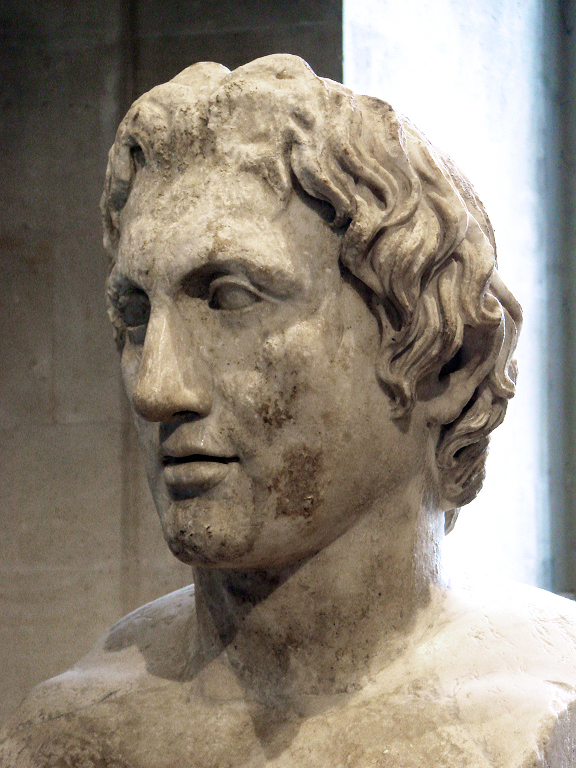
There is also a Roman copy of a Greek original of a Lysippos in the Glyptothek in Munich.

The British Museum[2], in their description of the Portrait head found in Alexandria (shown below), says:
Alexander was always shown clean-shaven, which was an innovation: all previous portraits of Greek statesmen or rulers had beards. …. Earlier portraits of Alexander tend to appear more heroic and mature, while posthumous portraits, like this example, portray Alexander as a more youthful, god-like character. He has longer hair, a more dynamic twist of the head and an upward gaze; in fact, more like the description of Alexander in literary sources.
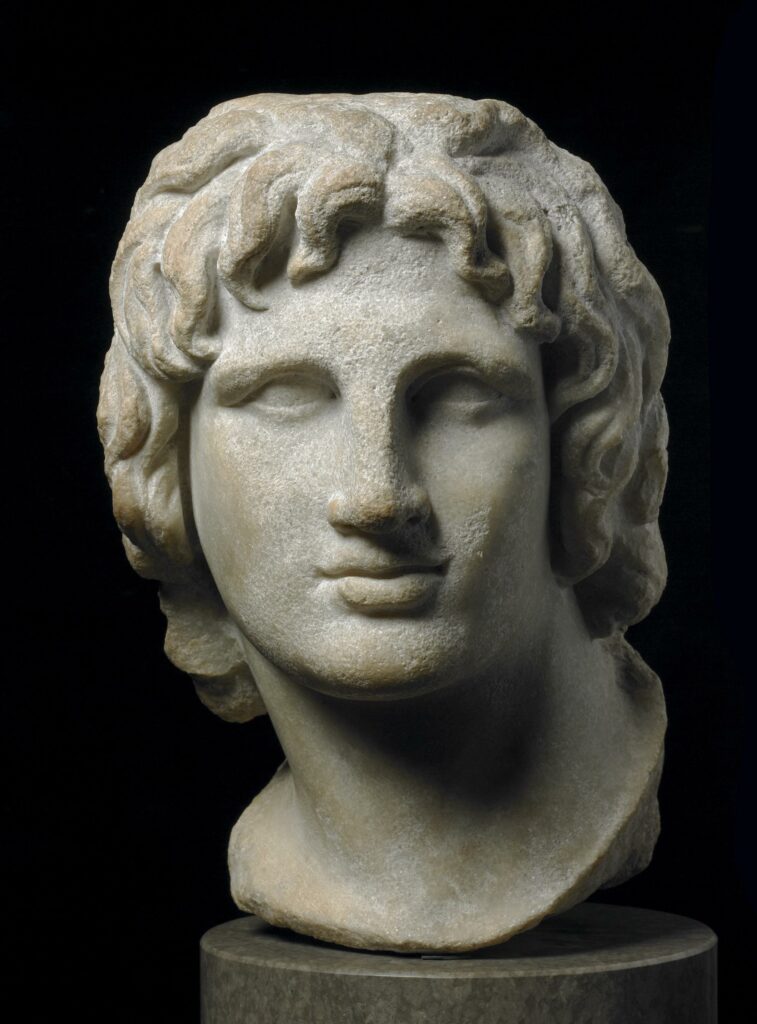
© The Trustees of the British Museum
The following statue is full length but depicts his head in a similar attitude, and dates from the 3rd century BCE.

A later statue has similar characteristics but is fully clothed:

Robin Osborne[3] says:
Alexander seems to have been acutely aware of the importance of his image, in life as well as in portraits. His decision to retain the beardlessness of the age at which he assumed the Macedonian throne must have been consciously taken …. This image fits in with nothing in the pre-existing portrait tradition, and has to be understood rather in the context of the creation of personals for mythological figures … just as in life he confused myth and reality in his emulation of the god Dionysos and of heroes such as Herakles and Perseus, and in his own aspirations to divinity, so in his image he took over the features developed to represent myth.
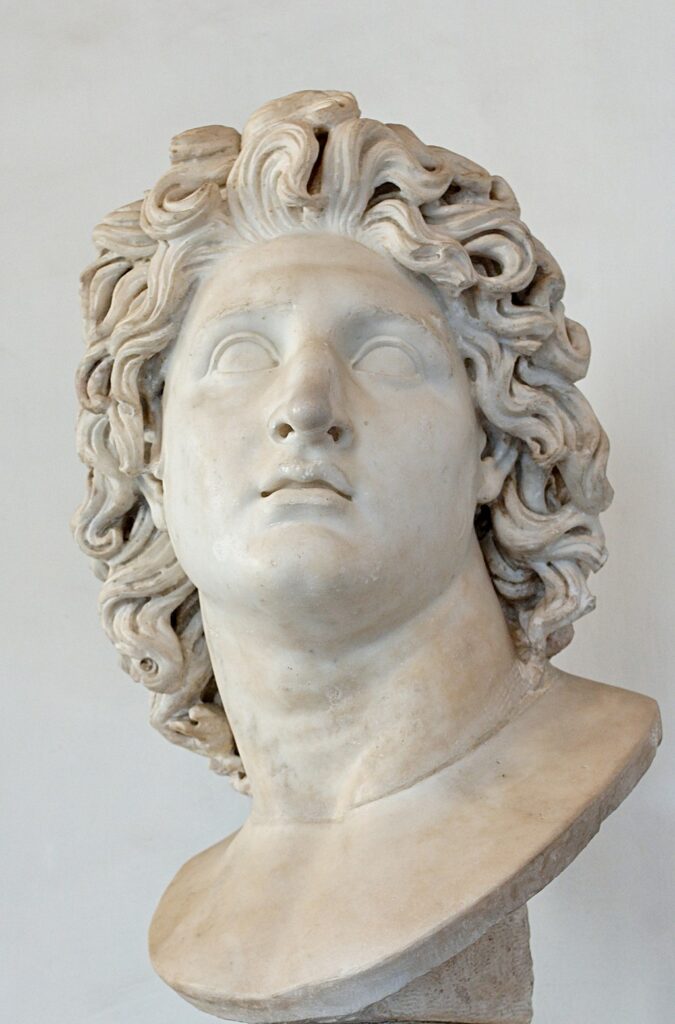

There are some coins minted during Alexander’s lifetime which similarly depict Herakles wearing a lion’s skin helmet, but not Alexander himself[4]. Some coins minted by rulers in Egypt after Alexander’s death depict Alexander himself as a god or cult hero. Robin Osborne[5] mentions examples where he is shown with horns typical of the Egyptian god Ammon, or the scalp of an elephant.

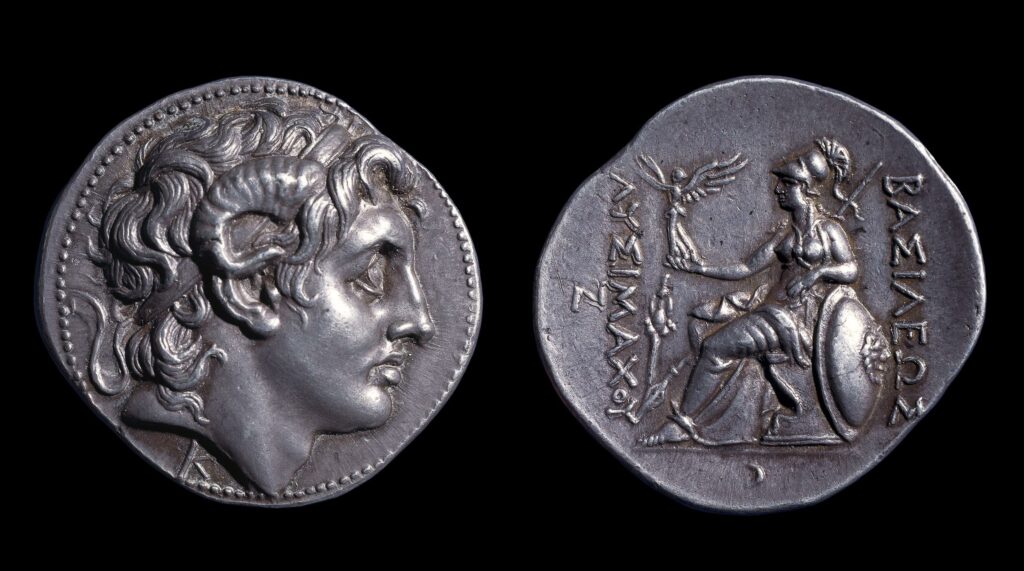
© The Trustees of the British Museum
Incidents from Alexander the Great’s life seem to have captured the imagination of the Romans and also of later artists and illustrators, in a variety of styles, not all of them historically accurate! I’ve included a few fun examples.
This Roman mosaic from Pompeii depicts Alexander with short dark hair, and sideburns, so this would perhaps not have met with his approval, if Plutarch is to be believed.


A more personal scene is depicted in the next artwork, also from Pompeii. Although it depicts a wedding, the “happy couple” do not appear particularly joyful!

These later examples are by illustrators or artists from the Renaissance onwards.



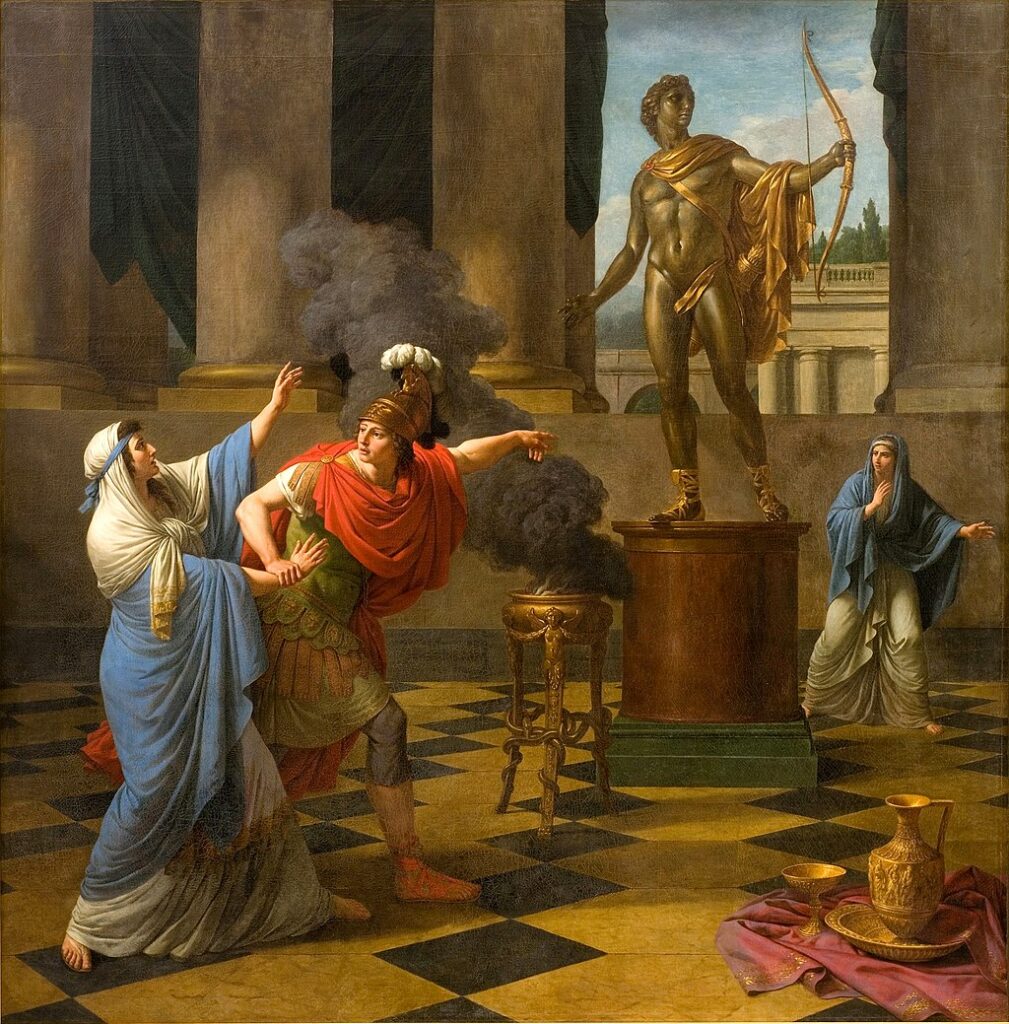
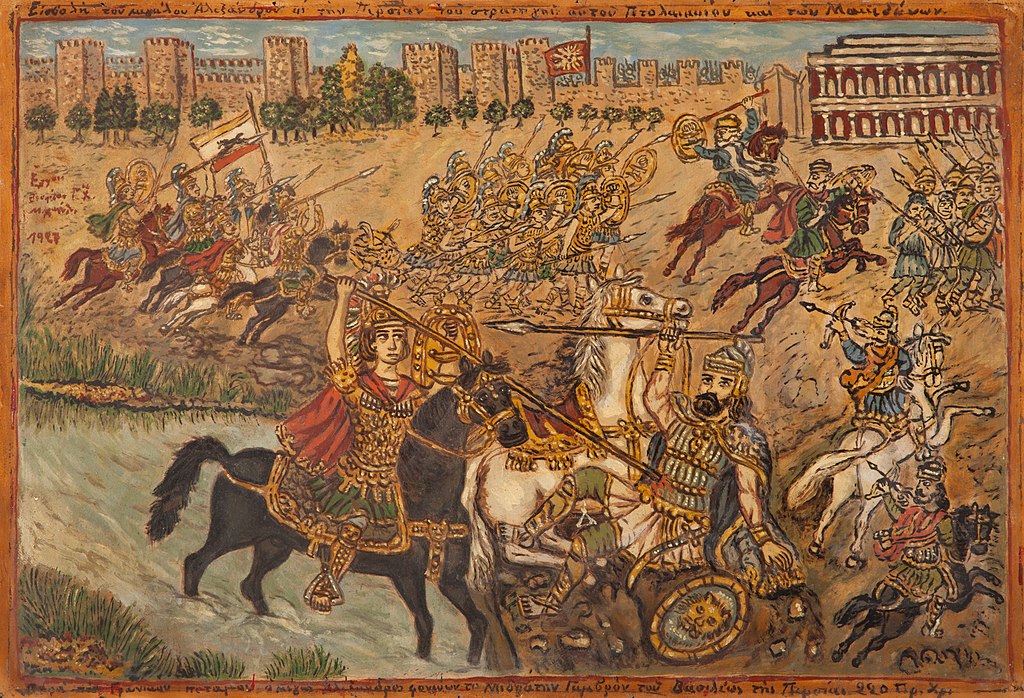
There are later legends associated with Alexander that do not feature in the history we are reading[6]. The one I most like is that he was taken aloft by two griffins to see the world! For some reason this incident is depicted in a number of churches. Here is just one example:
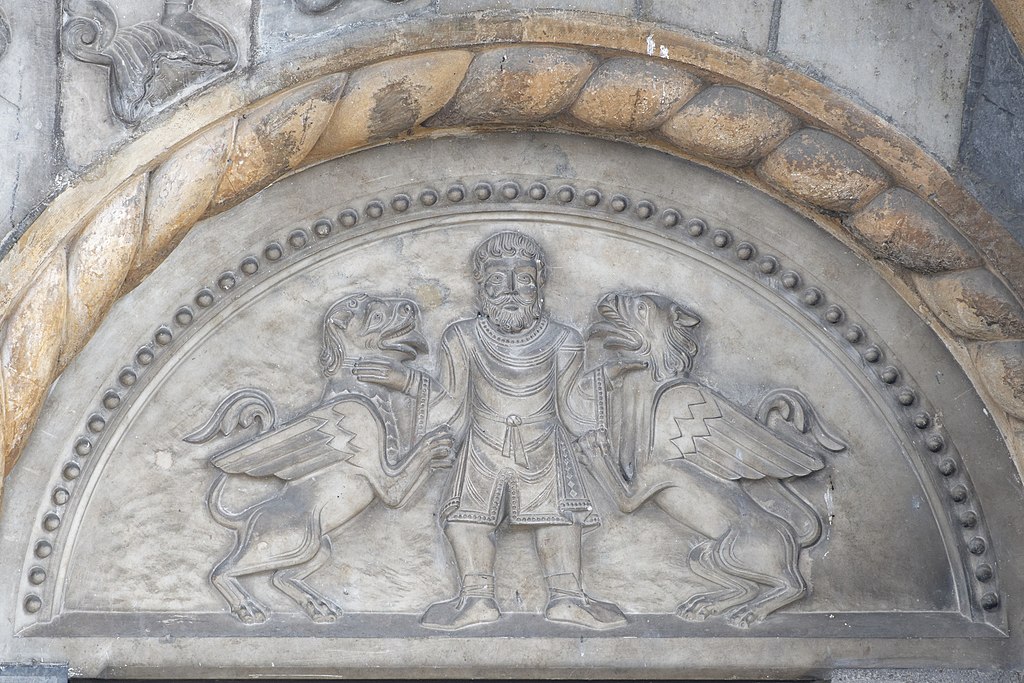
Alexander is commemorated in a more traditional style in modern statues, for example these in which he is shown fighting or on horseback.


How do you visualize Alexander the Great? Have any of you found other pictures of him which fit his own image of himself, or which contradict it? There are plenty of depictions to choose from, so please share them in the Forum!
Notes
1 Plutarch Alexander 4.1–2. Plutarch’s Lives with an English translation by Bernadotte Perrin. Cambridge, MA. Harvard University Press. London. William Heinemann Ltd. 1919. 7. Online at Perseus
2 British Museum, object number 1872,0515.1
3 Robin Osborne 1998 Archaic and Classical Greek Art Oxford, New York, page 223
5 Robin Osborne 1998, op cit. p223
6 See, for example, Wikipedia article ‘Alexander the Great in legend’
Image credits
Marble copy, 1st or 2nd century CE, of bronze sculpture by Lysippos. Inscribed “Alexander son of Philip of Macedonia”.
Photo: Eric Gaba (Sting), Creative Commons Attribution-Share Alike 2.5 Generic license, via Wikimedia Commons
Another view of the same bust from the right
(No photographer given), Creative Commons Attribution-Share Alike 3.0 Unported license, via Wikimedia Commons
Marble head of Alexander the Great. Roman copy (2nd century CE) of an original (c. 330 BCE)
Photo: Osama Shukir Muhammed Amin FRCP(Glasg) Creative Commons Attribution-Share Alike 4.0 International license, via Wikimedia Commons
Portrait head of Alexander the Great, 300– 50 BCE, said to be from Alexandria, Egypt
Creative Commons Attribution-NonCommercial-ShareAlike 4.0 International (CC BY-NC-SA 4.0) license
© The Trustees of the British Museum
Alexander the Great, signed “Means of Pergamon, son of Aias,” 3rd century BCE
Photo: Dosseman, Creative Commons Attribution-Share Alike 4.0 International license, via Wikimedia Commons
Marble statue of Alexander the Great, 1st century CE.
Photo: George E. Koronaios, Creative Commons Attribution-Share Alike 4.0 International license, via Wikimedia Commons
Marble bust of Alexander the Great as Helios. Roman copy of Hellenistic original from 3rd – 2nd century BCE.
Photo: Jastrow. Public domain, via Wikimedia Commons
Head of Alexander the Great wearing a lion’s pelt, c300 BCE
Photo: Carole Raddato
Creative Commons Attribution-ShareAlike 2.0 Generic (CC BY-SA 2.0) via Flickr
Coin with head of Alexander wearing an elephant head, from reign of Ptolemy I in Alexandria, c 323– 285 BCE
Photo: ArchaiOptix, Creative Commons Attribution-Share Alike 4.0 International license, via Wikimedia Commons
Tetradrachm, head of Alexander the Great with ram’s horn (obverse), and Nike (Victory) with shield and wreath (reverse), minted in Lampsacus, Turkey c 305 – 281 BCE
Creative Commons Attribution-NonCommercial-ShareAlike 4.0 International (CC BY-NC-SA 4.0) license
© The Trustees of the British Museum
Battle of Issus, mosaic, c 100 BCE: “Reconstruction of mosaic from the House of the Faun, Pompeii, after a painting by Apelles or Philoxenus of Eretria.”
Photo: Berthold Werner. Creative Commons Attribution-Share Alike 3.0 Unported license, via Wikimedia Commons
Close-up view of Alexander from mosaic of Battle of Issus.
Public domain, via Wikimedia Commons
Wedding of Alexander the Great and Barzine (Stateira) or Roxanne, House of the Golden Bracelet, Pompeii, 1st century BCE – 1st century CE
Photo: Fabien Bievre-Perrin and sharpened and upsized by Mary Harrsch. Public domain, via Wikimedia Commons
Unknown Flemish artist, late 15th century. Alexander, his men and beasts suffering from thirst by a river. Book illustration to Latin text of ‘The History of Alexander’s Battles’ (based on a Greek original).
Creative Commons CC0 1.0 Universal Public Domain Dedication via Wikimedia Commons
Marcantonio Raimondi, c 1500–1534: Alexander the Great commanding that the work of Homer be placed in the tomb of Achilles
Creative Commons CC0 1.0 Universal Public Domain Dedication, via Wikimedia Commons
Charles Le Brun 1661: The Queens of Persia at the feet of Alexander, or The Tent of Darius
Public domain, via Wikimedia Commons
Louis-Jean-François Lagrenée 1789: Alexander consulting the oracle of Apollo
Public domain, via Wikimedia Commons
Theophilos Hatzimihail, 1927: Alexander the Great killing Mithradates near the river Granicus in 220 BCE
Public domain, via Wikimedia Commons
Alexander raised up by griffins. Portal of the cathedral Oloron-Sainte-Marie
Photo: Marie-Lan Nguyen, Creative Commons Attribution 4.0 International license, via Wikimedia Commons
Alexander the Great in Macedonia Square, Skopje, Macedonia
Photo: Rašo. Creative Commons Attribution-Share Alike 3.0 Unported, 2.5 Generic, 2.0 Generic and 1.0 Generic license via Wikimedia Commons
Macedonian Monument – Alexander III – Prilep
Photo: Tashkoskim Creative Commons Attribution-Share Alike 3.0 Unported license, via Wikimedia Commons
Details and attributions are based on those on museum websites, Flickr, or Wikimedia Commons at the time of publication.
Images accessed July 2023
__
Sarah Scott is a member of Kosmos Society